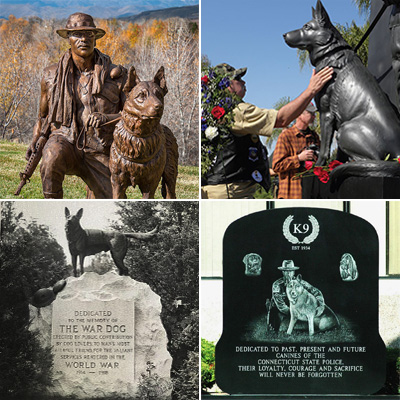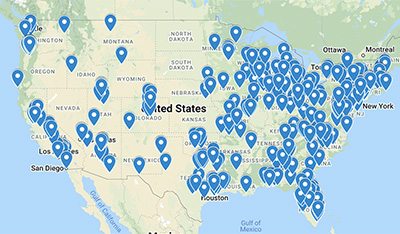
| |
| Home |
| 2025 Memorial Sites |
| Registration |
| Rider List |
| RULES and FAQs |
| Additional Rides |
| TOH Store |
| Archived Memorials |
| WELCOME! Banners |
| Donate |
| Contact Us |
War Dogs and K9 Heroes
|
 |
|
The Soldier Dog When the United States of America began using canines in combat, there was no going back. It was a decision which would change the course of war forever more, allowing troops to use animal companions in order to accomplish tasks which a human would normally have difficulty doing otherwise. In the beginning, over 30 different breeds were utilized for the war efforts, including but not limited to Airedale Terriers, Boxers, Shorthaired Pointers, Water Spaniels, and even Poodles. However, it was quickly discovered that certain breeds were better equipped for combat than others. Great Danes, for instance, proved to be excellent hunters due to their incredible sense of smell but were difficult to train because of their size and the fact that they were easily distracted. By the time World War II rolled around, the list of acceptable breeds had been limited down to only five: German Shepherds, Belgian Sheepdogs, Doberman Pinschers, Smooth Collies, and Giant Schnauzers. Others breeds, such as the Malinois and Retriever, were added later as the United States military came to discover their abilities. World War II was an important time for war dogs. Well over 11,000 canines had been procured and trained by the U.S. army – an impressive amount when one considers the mere 100 that had been enlisted for World War I. These four-legged soldiers were trained in one of seven roles, depending on their size, intelligence, and prowess. Attack Dogs were the most popular at the beginning of the war and they were trained to apprehend individuals; Tactical Dogs were used purely on an experimental basis in order to test camouflage material and gas masks; Scout Dogs (commonly known as Sentry Dogs) were meant to scan the surrounding area and alert their human counterparts to anything suspicious; Messenger Dogs were the primary means for soldiers on the battlefield to receive messages or packages, though they were being quickly replaced by walkie-talkies and other means of communication; Tracker Dogs (commonly known as Search And Rescue Dogs) worked alongside the medical corps and aided in finding wounded soldiers on the battlefield; Sledge Dogs were trained to navigate snow-heavy regions and to locate any missing persons who may have been buried or lost in the snow; Pack Dogs were similar to Messenger Dogs except for the fact that they were trained to transport heavy equipment, including small machine guns, ammunition, and crates of food. The Vietnam War was a crucial point for dogs of war. Many of the roles canines were used for in World War II were dropped altogether and only the Working Dogs, Scout Dogs, and Tracker Dogs made a comeback. However, an additional job had been added as technology worldwide grew. These new canines were known as Detection Dogs and they were commonly used in order to locate mines, hidden tunnels, trip wires, and booby-traps. Although only 3,750 dogs have been recorded as being sent with troops overseas, it is believed that close to 5,000 canines were actually trained. The grim truth behind these numbers comes to light when one realizes that only 204 dogs made it out of Vietnam. While some of the heroic dogs were killed in combat, most were either euthanized or left behind, treated as nothing more than equipment to be tossed out. Thankfully, that is no longer practiced and today's returning war dogs are frequently adopted stateside by their handlers or handlers' families. These four-legged soldiers aren’t just working alongside the United States military, they have also been trained to help in various other ways. Law enforcement, first responders, and fire departments have enlisted the help of canines. Police departments tend to train German Shepherds and Malinois for general K9 detail, Retrievers for narcotics and explosive detection, and Bloodhounds for search and rescue. Other mixed breeds may be used as well, but these are the four most common due to their intelligence and ability to do their job well. First responders have less restrictions on which breeds can be used, mostly because these canines work as therapy dogs to help people cope after a trauma. Search and Rescue dogs may also be used by first responders to help locate individuals who have been lost in a disaster. Fire Dogs were once used to help guide horses which would draw the firefighters’ carts of water. Nowadays, Fire Dogs are used as mascots and to locate any accelerants which may have been used to start a fire. With training similar to that used in the military, these canines can help subdue a dangerous individual, locate a missing person, and identify hazardous material. There will be three basic levels of finishers: Highly motivated riders can reach an even higher level: This challenge is to collect photos of War Dog and Law Enforcement K9 Memorials, as long as they are at least one foot tall. Law Enforcement K9s are defined as a dog in a working capacity such as bomb-sniffing, arson investigation, etc. A) The qualifying monument B) Your motorcycle* C) Rider flag(s) – passenger photos must include the passenger D) Enough of the background to identify the location, or photo be geotag enabled. IMPORTANT: When it is not possible to include your motorcycle with the memorial in a single photo for any reason, include a 2nd photo with your motorcycle and rally flag parked in nearby designated parking. *PARKING or RIDING on sidewalks or lawns is not permitted unless specifically authorized by local law enforcement or memorial caretakers. TOH scorers will have final say whether a site is allowed or not. |
 |
|
Click on the map above for an interactive map of known War Dog and K9 Heroes memorials. Click here for a GPX file (rev. 7/21/25), and an up-to-date listing by state here. The map and GPX file are provided by scorer Eric Marshall. For corrections, updates and/or additions, let Eric or Marlisa know at photos@tourofhonor.com NOTE: The list mentioned above has a column labeled “Restrictions.” Any locations labeled something other than “none” may have a restriction of some kind. Examples would include, but not be limited to: military installations, museums, offices, cemeteries, etc. These may be accessible only on certain days, have limited hours, require a special ID or guest pass, have an admission fee, etc. It is up to riders to pre-scout locations to determine access. Photos of museum doors, hangars, guard shacks or other barricades visited on days or during hours when access to the object of the visit isn't available, are not eligible for scoring.
|
|
|||




